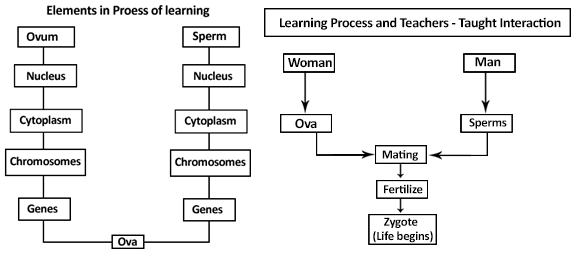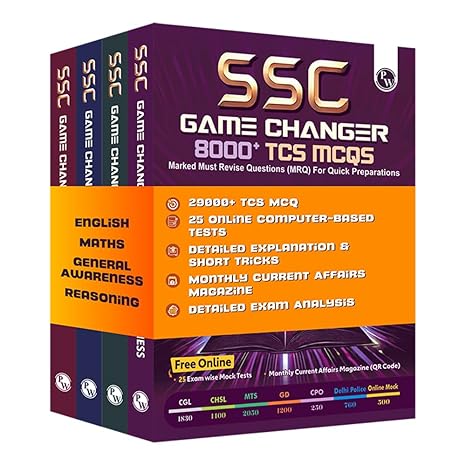Process of Teaching and Learning - Syllabus and Study Material
Principles of Teaching
General Principles of Teaching are
- Principle of activity
- Principle of linking with actual life
- Principle of planning
- Principle of division
- Principle of definite aims
- Principle of correlation
- Principle of individual differences
- Principle of co-operation
- Principle of revision
- Principle of remedial teaching
- Principle of healthy environment and proper control
Psychological Principles of Teaching
- Principle of motivation
- Principle of reinforcement
- Principle of training of senses
- Principle of automated study
- Principle of change, rest and recreation
- Principle of practice and exercise
- Principle of group dynamics
- Principle of sympathy and co-operation
- Principle of remedial teaching
- Principle of stimulation
- Principle of fostering creativity and self-expression
Process of Learning
Learning of a process means to do some activities together to gain experience. Total experience is based on the experience by activities and sub-activities. Thus learning is a broad process. It is life-long. Dashiel has called the following as factors of learning:
- Motivation - Every work which a man wants to do is controlled by motivation. Students study to get good job. Motivation takes us towards goal. Motivation makes a man more activated.
- Goal – There is a goal to learn a work. Man also has a goal in life. Man does not want to learn a work which is not goal-oriented. Thus man’s behavior should not be goal-less. Goal gives him a definite direction.
- Obstacle – During the achievement of goal, obstacles bound to arise. Due to them man behaves in a desired manner, only then he achieves his goal. Correct behavior can help control these obstacles.
- Various Responses – Man reflects many responses to overcome obstacles in achieving his goals, but all responses are not right. For achieving a goal, definite responses should be done.
- Reinforcement –In reinforcement all these activities & facts arise which force a student to act. Order by teacher, self-desire, respect for elders, social prestige all come under reinforcement. Those responses which are satisfactory & provides happiness, comes under reinforcement. All unsuccessful responses need to be forgotten.
- Integration & Generalization - The various aspects of learning are organized to produce new knowledge. Till new knowledge is not added, the process remains incomplete. Thus new knowledge becomes a part of the process and this entire process gets generalized.
Thus learning is not a specific activity. Under it many sub-activities are included which makes it total.


Age Specific Teaching and Positive Discipline
Understanding how children develop will help you know what to expect. Children constantly change and develop as they grow. Researchers have found that young children pass through specific stages of development along the way. The idea behind these “ages

And stages” is that certain behaviour is normal or appropriate at certain ages and not at others. The following table describes the development of children at certain ages and what teaching or disciplinary methods can be used for that age.

The Ages and Stages Approach to Discipline
| Age | Development | Teaching Disciplinary Tips |
| 5 years | Tends to be calm, quiet, well-balanced. Usually tries only what she (or he) knows she can do, so is comfortably well-adjusted. Friendly, loving, appreciative, wants to please and do the right thing; wants and means to be good; not yet able to admit to wrongdoing and, as much as she tries, does not always tell the truth. | Let them know what is and is not reasonable to expect. Many things teachers consider bad are often simply immaturities. Prevention is much better than giving a negative consequence. If you do so, however, do it calmly. The student’s wish to be good and do the right thing is strong. With luck, there should be relatively little need for negative consequences. |
| 6 years | Highly emotional Loves one minute, hates the next. Much confusion and trouble between self and others. May demand, rebel, argue, or fight. When in a good mood, is cheerful, energetic. and enthusiastic. Needs much praise, but behaviour often merits criticism. This only makes behavior worse. Notable yet to tell the difference between mine and yours. | Patience. Ignore refusal or be impersonal when student answers with “I won’t or “I can’t”. Praise-it may not be easy to find something to praise, but try hard; avoid resistance and confrontations; avoid sensitive issues if possible; give in on occasion, especially if it will lead to a positive behaviour or learning experience. |
| 7 years | Quiet, rather negative emotions. May be serious, self-absorbed, moody, worrisome, or suspicious. Very sensitive to other’s emotions. May feel disliked by others and that they are critical or making fun of them. Procrastinates, has a short memory, and is easily distracted. | Obedience problem may be because student is distracted. To have the student do a simple activity, tell him or her in advance and make sure he or she heard the directions. Remind the student before he or she forgets and does something else. Give small rewards for successes. |
| 8 years | Vigorous, dramatic, curious, impatient, and demanding. Not as moody age 7, but still sensitive. Wants time attention & approval; beginning to think abstractly; interested in and concerned about own possessions. | Give instructions in ways acceptable to the student. Time, attention, and approval are good motivators. Use problem-solving activities as a means to develop abstract thinking. Give small rewards for successes. |
| 9 years | Quieter than at age 8. Seems to be independent, responsible, dependable, and co-operative. May sometimes be temperamental, but is basically reasonable. Will take criticism fairly well if carefully phrased; great interest in fairness; group standards may be more important than adult standards. Very involved with self and may not hear when spoken to May appear absent-minded or indifferent. May show concern for others. | Promote responsibility through assigned (requested) tasks. Use cooperative learning, but monitor interpersonal activities. Use guided learning through projects, rather than constantly lecturing. |
| 10 years | Emotionally direct, simple, clear-cut, usually well-balanced, yet still childlike. Less anxious & demanding than at age 9. Most often good-natured and pleased with life. But may show sharp, violent temper. Can be very affectionate. Not a worrying age, yet a few earlier fears remain. Enjoys own humour, which may not be very funny to others. Happy age | Involve the student’s ability to distinguish good from bad, right from wrong, truth from untruth; best technique is to know what is reasonable to expect. Involve students in developing classroom committees, including disciplinary committees. Use humour in your teaching |
| 11-13 years | Early adolescence, time of rapid changes, Developing his or her own identify and becoming more independent. Need for privacy increases and may be very sensitive to teasing. Moody. Importance of friends increases. | Let your students know that you care. Arrange “sharing” sessions or activities (such as essays) concerning student’s experiences and feelings. Maintain mutual respect. Limit criticism and nagging. Do not allow teasing or tolerate insults. |
| 14-16 years | Middle adolescence. Increasing independence. Sexual development and self-centred-ness. Very body or appearance conscious. Thinking is less childlike; they consider facts d can make good decisions | Encourage positive relationships through sharing. Give ideas of creative things to do with their friends as part of learning. Set reasonable limits and be consistent and fair in enforcing rules. Make sure they know the rules and negotiate meaningful consequences. Give praise and recognize positive behaviour and accomplishments. Share your own beliefs, concerns, and values about the world. Encourage your students to call a respected adult friend when they need advice. Continue to give praise |
| 17-21 years | Late adolescence. Becoming more independent and self-reliant; less influenced by peer groups; developing adult-thinking capacity. Generally easier to handle than those experiencing early and middle adolescence. Exploring more long-term relationships. May have an option on everything. Self-consciousness about their appearance lessons. | Continue the actions for 14-16 year old above. Regularly ask your students what they think and believe. Respect their uniqueness and encourage such respect for other. Encourage independent decision-making. Continue to give praise. |
Important Features Regarding Teaching and Learning
- Lessons need to be structured around “big ideas” rather than unconnected pieces of information. In this way, children have an umbrella under which they can fit new information with what they already know. A big idea can be something like “water is important to life,” and the topic could be “today we will learn how to keep “water clean.”
- We need to consider children’s development needs. Some children will need more time to progress than others.
- We need to be facilities of learning and recognize the unique characteristics of our teachers. The learning environment should support all learners.
- Students need to talk together with their teacher and with one another during activities that are both individual and team-oriented.
- We need to plan activities that encourage ALL children to work as a team, such as working in pairs or small groups on relevant tasks.
- Students must be able to find the curriculum useful to them, be encouraged to ask questions and consider information, and be able to ask construct their own understanding of the subject matter.
- We need to ask good questions to allow students, to explain their ideas. Rather than asking questions that require a “Yes” or “No” answer only, we need to ask open-ended questions to allow children to express their views, ideas, and opinions;’ for instance, we can ask questions that end with “what do you think?”
- Thoughtful questions asked by the teacher and active discussion among students will stimulate to search for information. Interacting with others, receiving new information, and reflecting on ideas help children to construct new knowledge.


0 Comments